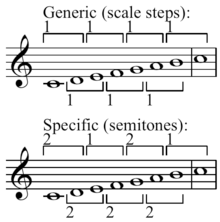Maximal evenness
In scale (music) theory a maximally even set (scale) is one in which every generic interval has either one or two consecutive integers specific intervals-in other words a scale whose notes (pcs) are "spread out as much as possible." This property was first described by John Clough and Jack Douthett[1]. Clough and Douthett also introduced the maximally even algorithm. For a chromatic cardinality c and pc-set cardinality d a maximally even set is


where k ranges from 0 to d - 1 and m, 0 ≤ m ≤ c - 1 is fixed and the backet pair is a floor function. An excellent discussion on these concepts can be found in Timothy Johnson's book on the mathematical foundations of diatonic scale theory.[2] Jack Douthett and Richard Krantz introduced maximally even sets to the mathematics literature.[3][4]
A scale is said to have Myhill's property if every generic interval comes in two specific interval sizes, and a scale with Myhill's property is said to be a well-formed scale.[5] The diatonic collection is both a well-formed scale and is maximally even. The whole-tone scale is also maximally even, but it is not well-formed since each generic interval comes in only one size.
Second-order maximal evenness is maximal evenness of a subcollection of a larger collection that is maximally even. Diatonic triads and seventh chords possess second-order maximal evenness, being maximally even in regard to the maximally even diatonic scale—but are not maximally even with regard to the chromatic scale. (ibid, p.115) This nested quality resembles Fred Lerdahl's[6] "reductional format" for pitch space from the bottom up:
| C | E | G | C | |||||||||
| C | D | E | F | G | A | B | C | |||||
| C | D♭ | D | E♭ | E | F | F♯ | G | A♭ | A | B♭ | B | C |
- (Lerdahl, 1992)
In a dynamical approach, spinning concentric circles and iterated maximally even sets have been constructed. This approach has implications in Neo-Riemannean Theory, and leads to some interesting connections between diatonic and chromatic theory.[7] Emmanuel Amiot has discovered yet another way to define maximally even sets by employing discrete Fourier transforms.[8][9]
Carey, Norman and Clampitt, David (1989). "Aspects of Well-Formed Scales", Music Theory Spectrum 11: 187–206.
References
- Clough, John; Douthett, Jack (1991). "Maximally Even Sets". Journal of Music Theory (35): 93-173.
- Johnson, Timothy (2003). Foundations of Diatonic Theory: A Mathematical Based Approach to Musical Fundamentals. Key College Publishing. ISBN 1-930190-80-8.
- Douthett, Jack; Krantz, Richard (2007). "Maximally Even Sets and Configurations: Common Threads in Mathematics, Physics and Music". Journal of Combinatorial Optimization. 14: 385-410.
- Douthett, Jack; Krantz, Richard (2007). "Dinner Tables and Concentric Circles: A harmony of Mathematics, Music, and Physics". College Mathematics Journal. 39 (3): 203-211.
- Carey, Norman; Clampitt, David (1989). "Aspects of Well-Formed Scales". Music Theory Spectrum. 11: 187-206.
- Lerdahl, Fred (1992). "Cognitive Constraints on Compositional Systems". Contemporary Music Review. 6 (2): 97-121.
- Douthett, Jack (2008). "Filter Point-Symmetry and Dynamical Voice-Leading". Music and Mathematics:Chords, Collections, and Transformations. Eastman Studies in Music: 72-106. Ed. J. Douthett, M. Hyde, and C. Smith. University of Rochester Press, NY. ISBN 1-58046-266-9.
- Armiot, Emmanuel (2007). "David Lewin and Maximally Even Sets". Journal of Mathematics and Music. 1 (3): 157-172.
- Armiot, Emmanuel (2016). Music Through Fourier Space: Discrete Fourier Transform in Music Theory. Springer. ISBN 9783319455808.